HighlightsProfessor Shiro Maeda and colleagues at University of the Ryukyus, Okinawa, Japan, performed comprehensive genetic study using 1,240 individuals living in the Miyako Islands as a part of the Okinawa Bioinformation Bank Project. The researchers identified three genetic subpopulations in the Miyako Islands, Miyakojima-northeast, Miyakojima-southwest and Irabu/Ikema subpopulations. The study, published in the Molecular Biology and Evolution, is the first to show the presence of genetic subpopulations within such a small islands-group (204 square kilometers). The Irabu/Ikema subpopulation firstly split away from the ancient Ryukyu population during the Gusuku period (about 500-900 years ago), and experienced a drastic decrease in the population size around 10 generations ago, which may be explained by one remarkable disaster during this period (the Great Tsunami of Meiwa). The two recent migrations into Miyakojima might occur during the Ryukyu Kingdom period (about 250-810 yeas ago). The present study provides important information being useful not only to understand the population history of the Ryukyu Archipelago, but also to identify novel genetic factors related to susceptibility to several common and/or rare diseases, and to establish the future precision/personalized medicine. |
The Ryukyu Archipelago makes up the southernmost islands of Japan (Fig. 1) and mainly consists of the Amami, Okinawa, Miyako, and Yaeyama Islands. The Miyako Islands are located between Yaeyama and Okinawa Islands and are comprised of eight islands: Ikema, Irabu, Kurima, Minna, Miyakojima, Ogami, Shimoji, and Tarama (here, “-jima” is used for “Island” to distinguish it from “Islands”). In these islands, about 55,000 individuals are living within a total area of 204 square kilometers.
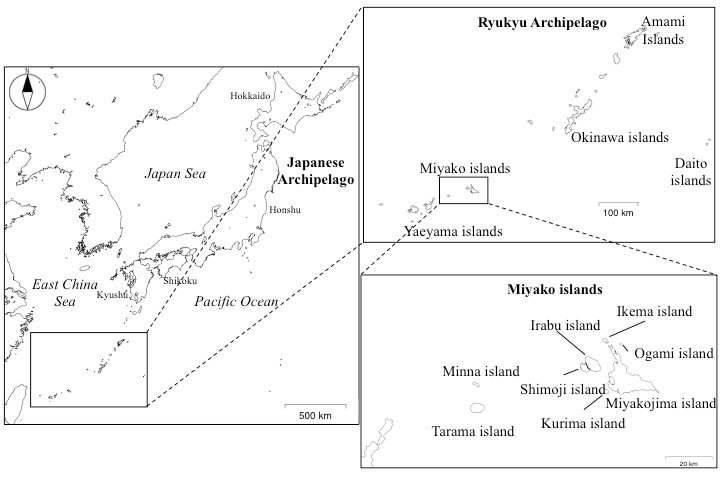
Figure 1. Geographic location of the Ryukyu Archipelago
Archaeological studies have shown that human bones dating to 31–28 kilo before present were excavated from the Pinza-Abu Cave site on Miyakojima, indicating that human settlement on the island dates back to the Paleolithic period. However, genetic analysis in modern Ryukyu people suggested that the Paleolithic people in the Ryukyu Archipelago are not the main ancestors of modern Ryukyu people, but rather that modern Ryukyu people are descendants of migrations from the Japanese Archipelago in the Neolithic Period or later. However, the detailed population structure and the origin of people living in the Miyako Islands has not yet been elucidated.
From 2016, University of the Ryukyus launched the biobank project in Okinawa, called Okinawa Bioinfomation Bank (OBi) Project, which is promoted by Cabinet Office, Ministry of Education, Culture, Sports, Science and Technology (MEXT) in Japan, and Okinawa Prefectural Government. As a part of OBi Project, Professor Shiro Maeda and colleagues have collected plasma, genomic DNA and clinical information from more than 18,000 individuals living in the Okinawa prefecture. From these samples, the researchers genotyped more than 600,000 single nucleotide polymorphisms (SNPs) for 1,240 individuals living in Miyako Islands, and these data were utilized for population genetic analysis.
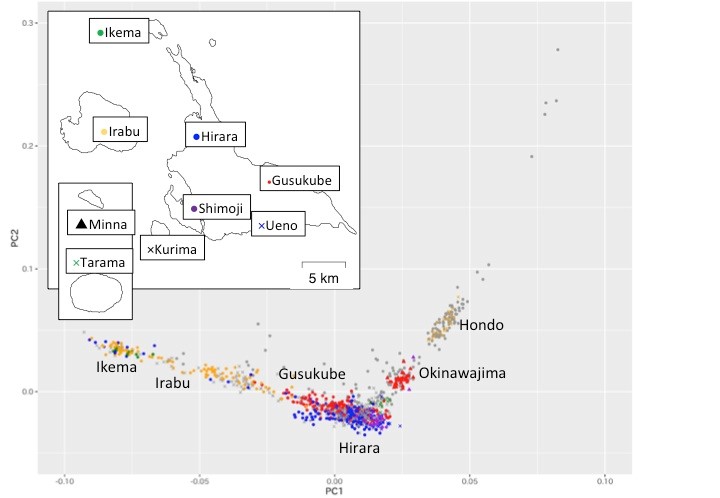
Figure 2. A PCA plot using genotype data for individuals living in the Miyako Islands
The principal component analysis (PCA) plot using genome-wide SNPs data for individuals living in the Miyako islands obtained by OBi Project indicated that there were several genetic clusters, corresponding to individuals from Miyako Islands, Okinawajima, and Japanese Archipelago (Hondo), respectively (Fig. 2). In this analysis, they found that the Miyako cluster was widely scattered along the PC1 axis compared to other clusters. It is suggested that genetic heterogeneity exists within the Miyako populations. Until 1902, free migration within the Miyako Islands was restricted by implementation of the capitation tax system which may have enhanced genetic diversity within the Miyako Islands.
To elucidate genetic population structure within the Miyako people in more detail, they conducted a haplotype-based analysis, which more sensitively detects genetic differences. The result indicates that the Miyako people are divided into three subpopulations corresponding to geographic regions in the Miyako Islands (Miyakojima northeast, Miyakojima southwest, and Irabu/Ikema), with one exception; Nishihara that belongs to the Miyakojima northeast region (Fig. 3). Based on information in the literature, the Nishihara settlement was established by immigrants from Ikema island in 1873. Thus, their genetic analysis was consistent with historical documentation.
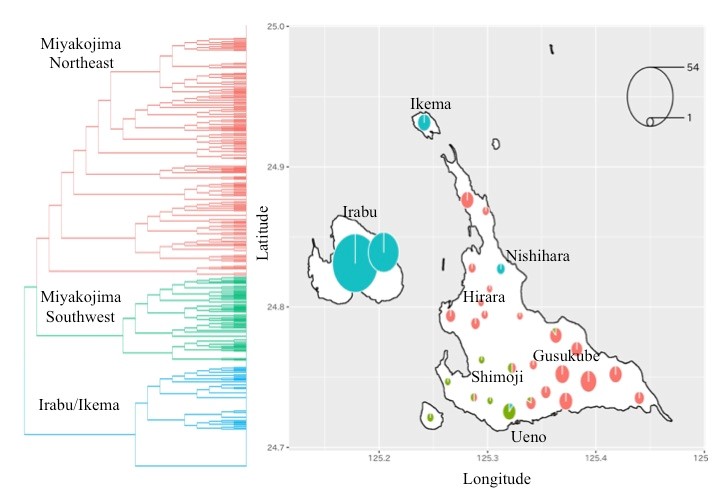
Figure 3. Haplotype-based analysis with geographic information
Left panel: Dendrogram generated by the FineSTRUCTURE program. The Miyako population was divided into 3 subpopulations denoted by red, green, and blue individuals. Right panel: Results of the FineSTRUCTURE analysis were mapped to the birthplaces of grandparents.
They inferred recent demographic histories of the Miyako population using haplotype information. Although the effective population size of Miyakojima populations had gradually increased, the Irabu/Ikema population seemed to have experienced a drastic decrease in effective population size around 10-15 generations ago (Fig. 4). Although there are several possible explanations for this bottleneck in Irabu/Ikema population, one remarkable disaster during this period is a strong candidate. A large earthquake and a subsequent tsunami hit the Yaeyama and Miyako Islands in 1771 (the Great Tsunami of Meiwa). In addition, there were large migrations from Ikema to Miyakojima after this disaster. Since many people on the Miyakojima also died in the tsunami, it was difficult for several settlements to keep city functions, so the government forced people to move from Ikema to Miyakojima. It is possible that these events were involved in the genetic bottleneck they found.
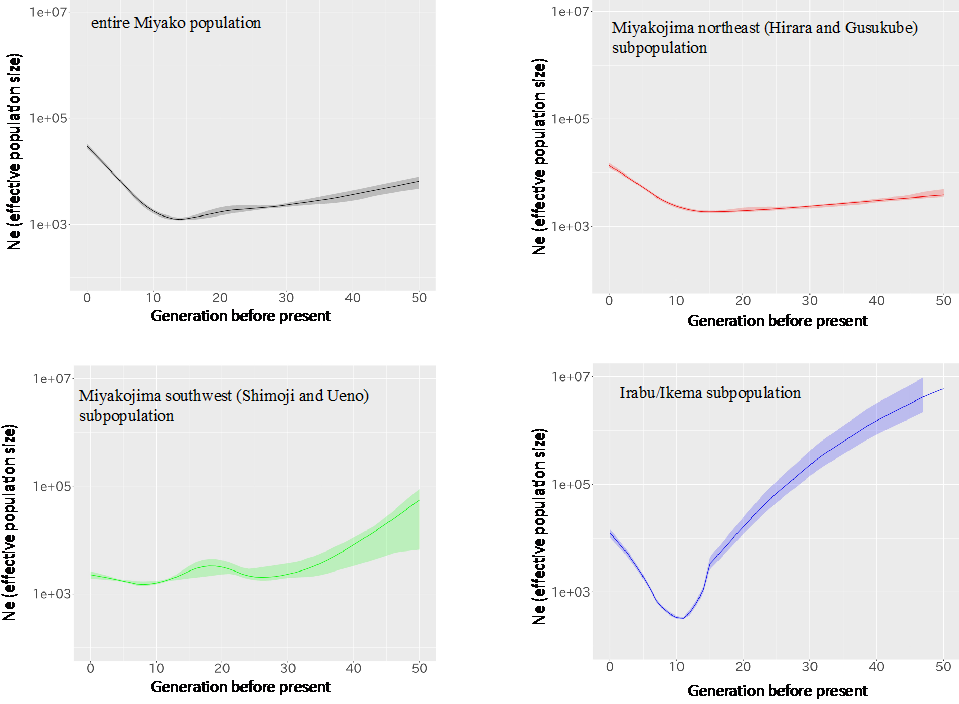
Figure 4. Inferred demographic histories
Patterson’s D statistics provides information about gene flow among focal populations. They calculated D statics among Miyako and other populations (JPT, CHB, Okinawajima, and Jomon), and found that Miyakojima populations experienced different history against Irabu/Ikema population. Calculated D statistics indicate that there is little evidence for the gene flow from other population to the Irabu/Ikema population, whereas the Miyakojima populations showed signatures of migration from other populations, suggesting that the Irabu/Ikema population received different gene flow from those of the Miyakojima populations. Although they could not clarify the source population of gene flow, immigration from the Northern islands, i.e. Okinawajima and so on, to Miyakojima islands might be related at least in part.
From these results, they assumed demographic model and estimated parameters, such as divergence times, migration rates, and population sizes (Fig. 5). In proposed model, the Irabu/Ikema population firstly split away from the ancestral Ryukyu population about 57-38 generations ago (about 1,710-950 years ago), followed by a split of the Miyakojima southwest population from the ancestral Ryukyu population about 27-10 generations ago (about 810-250 years ago), and the differentiation of the ancestral Ryukyu population into two populations (Miyakojima northeast and Okinawajima populations) about 18-2 generations ago (about 540-60 years ago). Thus, there were two waves of migrations into Miyako Islands from outside. The oldest migration wave might generate the ancestral Irabu/Ikema population and then recent migration was related to the ancestral Miyakojima population. Considering archaeological evidences, the time of migration into Irabu/Ikema might be back to the Gusuku period (900−500 BP), and the recent migration into Miyakojima might occur during the Ryukyu Kingdom period. These migrations influence the current population genetic structure of Miyako Islands.
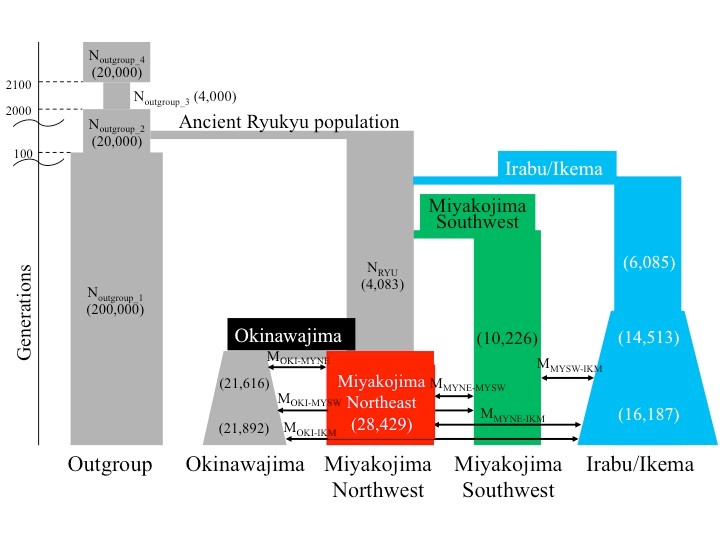
Figure 5. Estimated demographic model
“In this study, we produced genetic evidence that reveals the previous population isolation history and gene flow among people living in the Miyako Islands. The genetic structure we observed likely reflects past events experienced in the Miyako Islands, such as migrations and disasters. This study has provided interesting novel insights and serving as blueprint for similar studies. We are currently attempting to accumulate more genetic information derived from the Ryukyu Archipelago with clinical information through the OBi Project, and such data will enable to understand the population history of the Ryukyu Archipelago further and be useful to identify novel genetic factors related to susceptibility to several common and/or rare diseases” said Professor Maeda.
<Citation>
(1)Title:Fine-scale genetic structure and demographic history in the Miyako Islands of the Ryukyu Archipelago
(2)Journal:Molecular Biology and Evolution
(3) Authors:Masatoshi Matsunami, Kae Koganebuchi, Minako Imamura, Hajime Ishida, Ryosuke Kimura, Shiro Maeda*
(4)DOI:10.1093/molbev/msab005
(5) Abstract URL:https://doi.org/10.1093/molbev/msab005
